Lanzarote is the fourth largest of the Canary Islands and sits in the Atlantic Ocean, about 125 km off the west coast of Africa. It’s a small island with remarkable volcanic landscapes, beautiful beaches and a year-round average temperature of 25°C.
So if you’re wondering what to do in Lanzarote, the answer is quite a lot, actually… So much that we’ve returned a few times to explore everything the island has to offer.
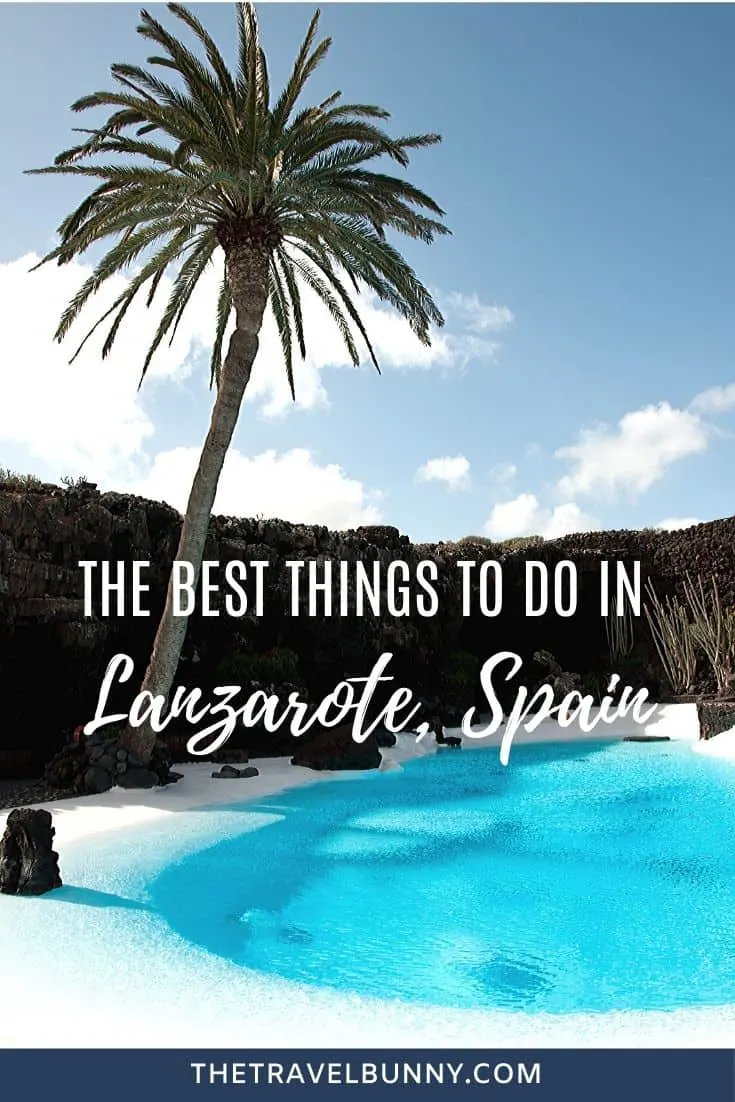
This post may contain affiliate links, which means that we may earn a small commission, at no extra cost to you, for qualifying purchases. More info: disclosure.
The best things to do in Lanzarote
Contents
Lanzarote might be small, but it punches well above its weight in terms of sightseeing. As well as wineries, white-washed villages, luxury villas and national parks, it’s home to some unique visitor attractions and interesting places to visit. If you want to know the best things to do in Lanzarote, you’ve come to the right place.
When I’ve visited, I’ve discovered a small island big on unusual and fascinating sights. At just 60 km (37 miles) long and 25 km (16 miles) wide, Lanzarote is ideal to explore by car. You can get around almost the entire island in a day or two, which gives you plenty of time to spend on the beach or by the pool after your adventures.
There are things to do in Lanzarote for everyone from art lovers to outdoor enthusiasts, nature buffs and wine connoisseurs. Water lovers aren’t left out, with water activities like scuba diving, snorkelling and sailing available from Lanzarote’s gorgeous sandy beaches. Here’s what to do in Lanzarote for every kind of traveller.
My favourite things to do in Lanzarote
These are my top five things to do in Lanzarote which I feel shouldn’t be missed. Make these your priority if you’re short on time.
- Timanfaya National Park and the Parque Natural de los Volcanes – the unique volcanic landscapes of Lanzarote shouldn’t be missed.
- Visit Jameos del Agua, a volcanic cave and blue lagoon created created by renowned Lanzarote artist Cesar Manrique
- Take a wine tour of Wine Tour of La Geria and sample some the island’s excellent wines
- Visit the island of La Graciosa – get off the beaten track and take the short 35-minute ferry ride for a day trip and spend time relaxing on this small island
- Swim in the natural pools around the island
Compare the best car hire rates for Lanzarote
César Manrique’s legacy
Lanzarote’s famous architect, César Manrique, had a significant influence on the island’s planning regulations. He lobbied successfully to ensure that any new construction would be in keeping with the island’s traditional style and colours, with no high-rise buildings permitted.
This means there are no tower blocks along the coastline, giving the island a more traditional Spanish feel than some of the other Canary Islands like Tenerife or Fuerteventura.
Manrique’s ethos was to combine art and nature in a unique and sustainable way. He was an eco-warrior of sorts and well ahead of his time. Visiting some of the César Manrique attractions was top of my list of things to do on Lanzarote, so that’s where I’ll start.
I want to extract harmony from the earth to unify it with my feeling for art
César Manrique
The cactus garden and windmill
What to do in Lanzarote if you love plants? A visit to the Jardin de Cactus is a great way to fill an hour or two, even if you’re not really into cacti. It’s an impressive garden and fabulous to photograph.
The Jardin de Cactus is a César Manrique creation built into an old quarry; a perfect example of architecture integrated into the landscape. You’ll find the garden in the north of the island between Mala and Guatiza.
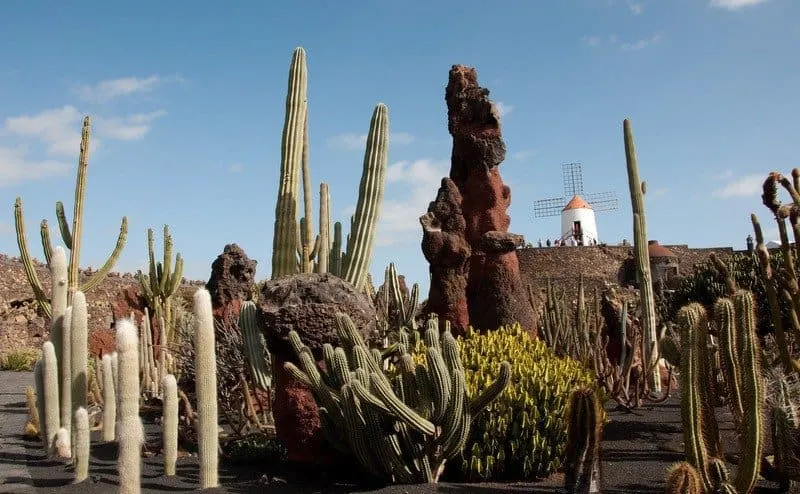
The Cactus Garden houses over 7,500 different species of cacti from around the world and has been established for over 25 years. This means some of the cacti are now pretty big.
The dark grey lava stone used to build the walls and terraces contrasts nicely with the prickly plants. The cacti are interspersed with volcanic stone sculptures, and there are Manrique design touches throughout, from quirky cactus-shaped door handles to unusual signs for the toilets.
Looking for somewhere to stay in Lanzarote? Check rates and availability
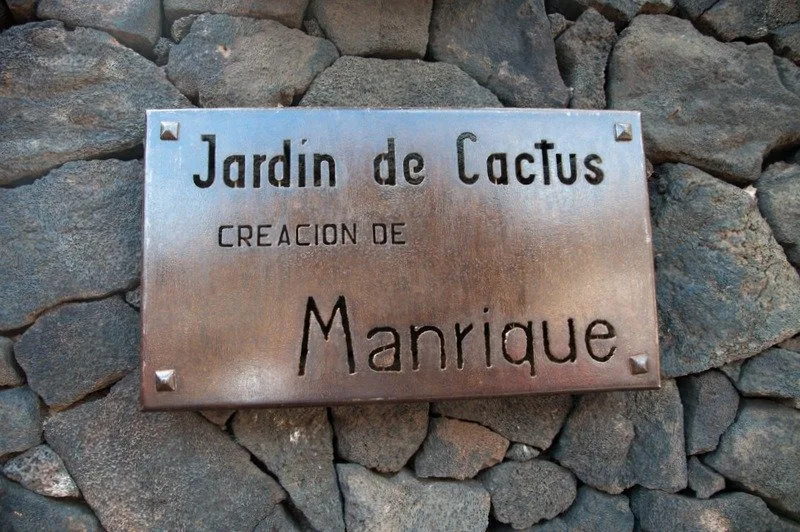
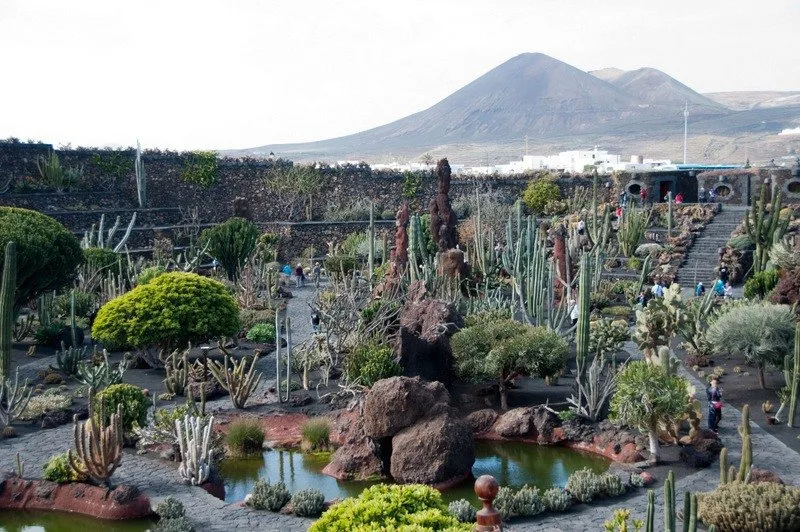
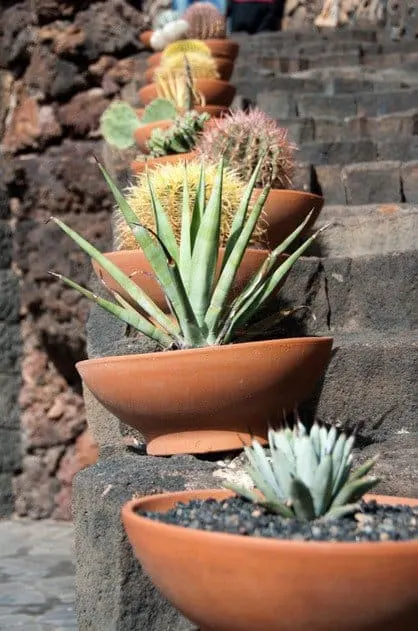

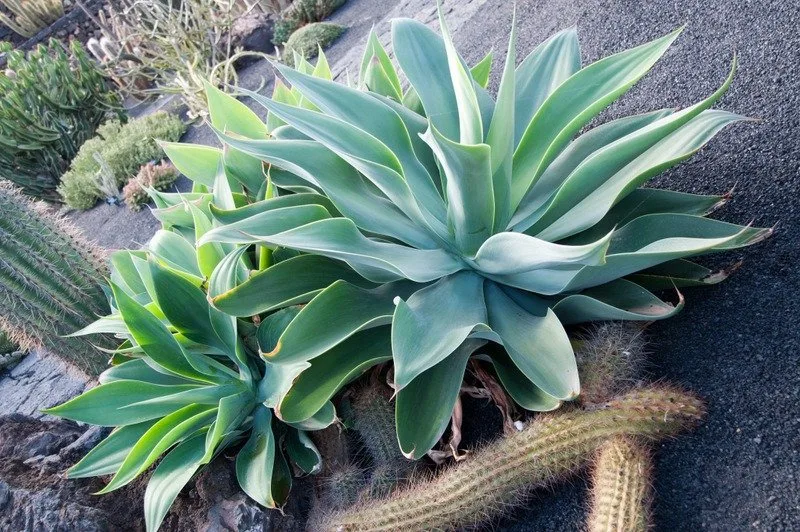
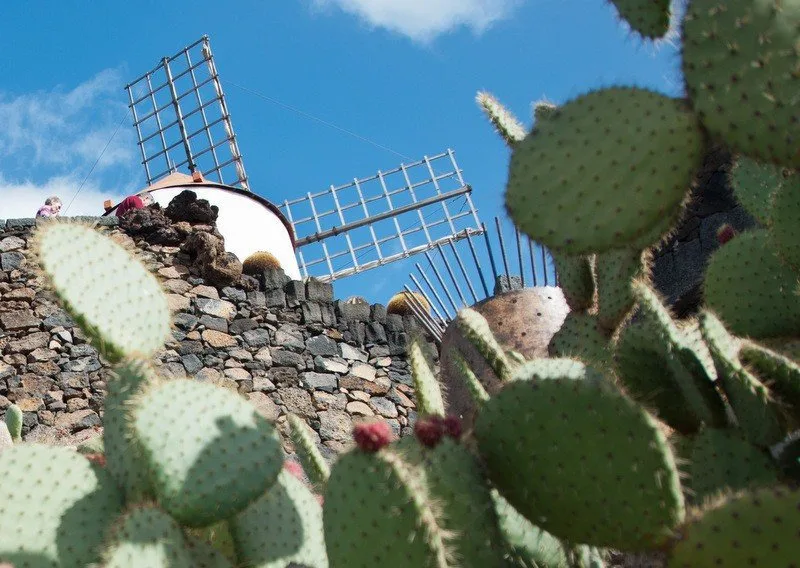
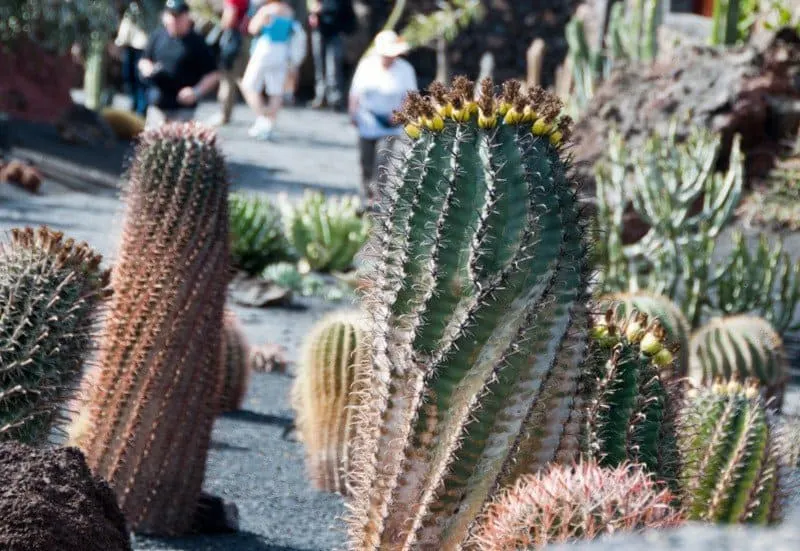
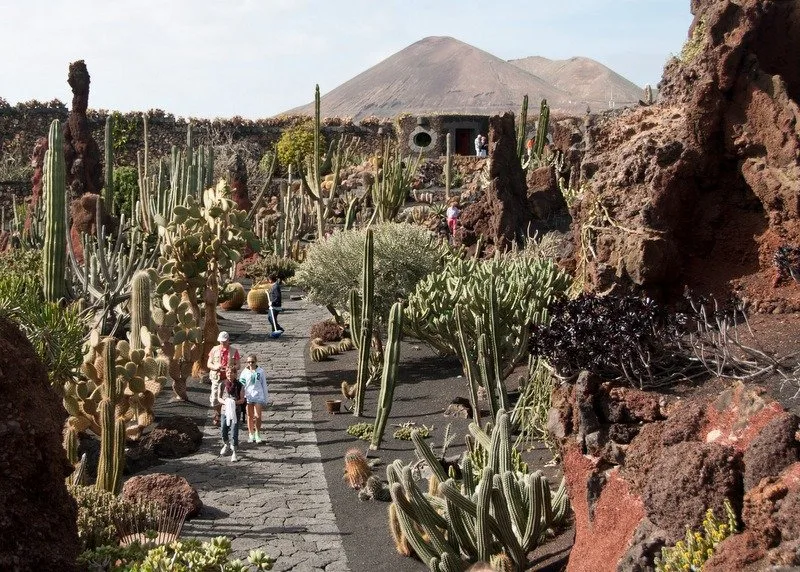
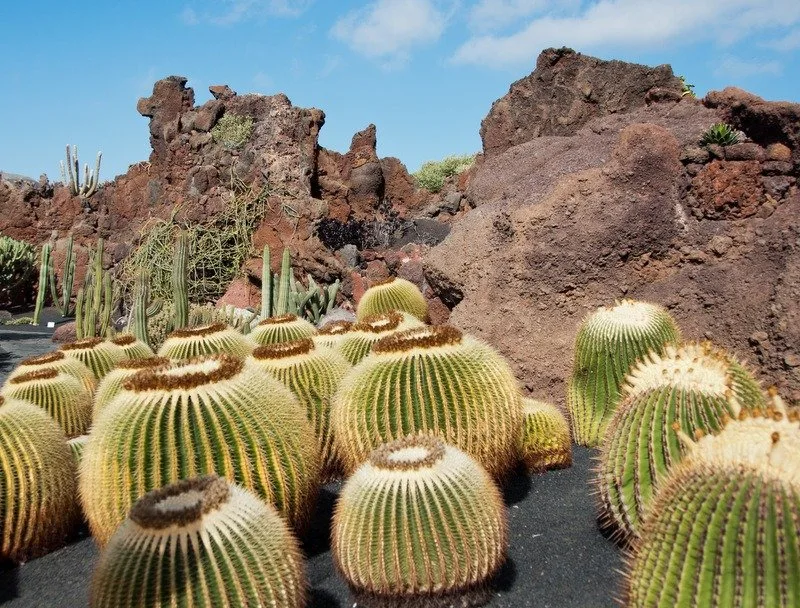
Most of the Cactus Garden can be explored through its sloping pathways and ramps. However, there are some pretty steep steps in places that aren’t suitable for everybody.
You can enjoy wonderful views across the gardens from the windmill’s base while, inside the windmill, curved wooden stairs lead you up to see the mill’s workings. There’s also a cafe and gift shop selling souvenirs and, unsurprisingly, cacti.
César Manrique’s Jardín de Cactus is open every day from 10:00 to 17:45. It costs €6.50 per adult and €3.25 per child (7-12 years), discounts for residents apply.
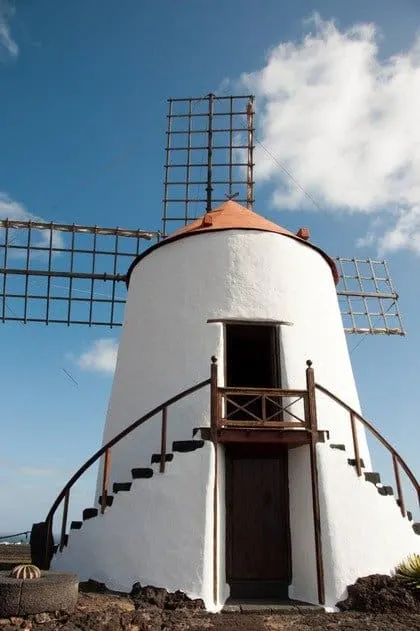
Jameos del Agua
Los Jameos del Agua lie inside a lava tube or tunnel formed from La Corona’s volcanic eruptions around four thousand years ago. The idea of exploring a lava tube was a definite must-see for me.
A ‘Jameo’ is a volcanic cave made of lava rock and with a collapsed roof. There are many of these caves, or tubes, on the island but del Agua is probably the best known. It’s located in the north of Lanzarote and is part of the Atlantida cave system.
Looking for somewhere to stay in Lanzarote? Check rates and availability
Artist César Manrique had the idea of turning the ‘jameos’ into a visitor centre with a restaurant, museum, tropical gardens, swimming pool and a 600-seat auditorium. All this within a lava tube makes a very unique Lanzarote attraction.
Underground Lagoon
When we arrived, we descended a spiral staircase to an underground saltwater lagoon known as Jameo Chico (little Jameo).
Look closely, and you’ll see thousands of the ‘glow in the dark’ crabs in the crystal clear waters. These tiny, blind albino crabs (Munidopsis Polimorpha) are the symbol of Los Jameos del Agua, and they dot the lake floor like a starry sky.
A short walk alongside the lake through the lava tube brings you to a lush, plant-filled garden and a vivid turquoise pool with a solitary palm tree bowing over it. The calm waters of the lagoon makes the scene picture-postcard perfect.
The 600-seater auditorium, added in 1987, is a venue for concerts and festivals and takes up the whole of an underground lava bubble. You can take a look around during the day, and the acoustics are pretty impressive, so I imagine going in the evening for a concert would be fantastic.
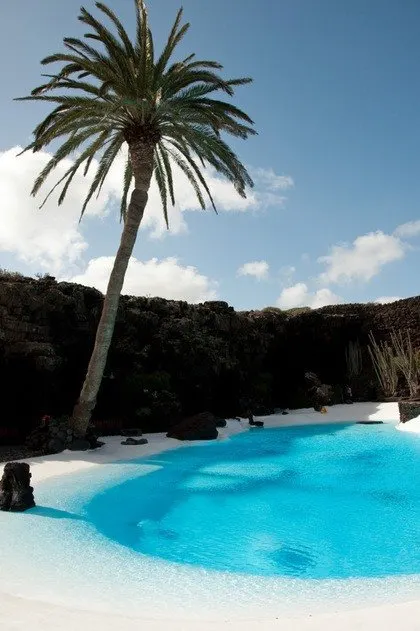
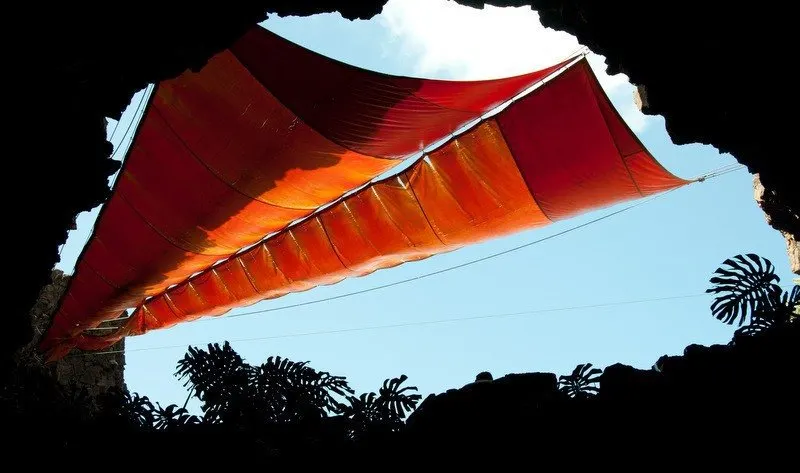
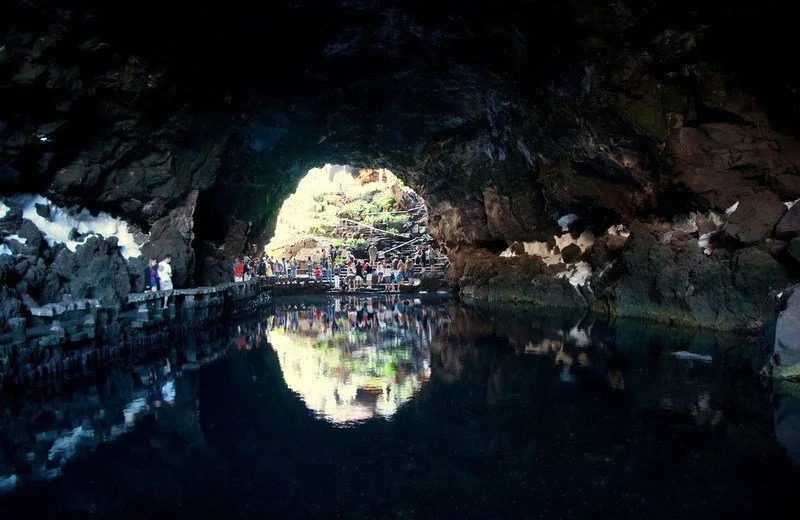
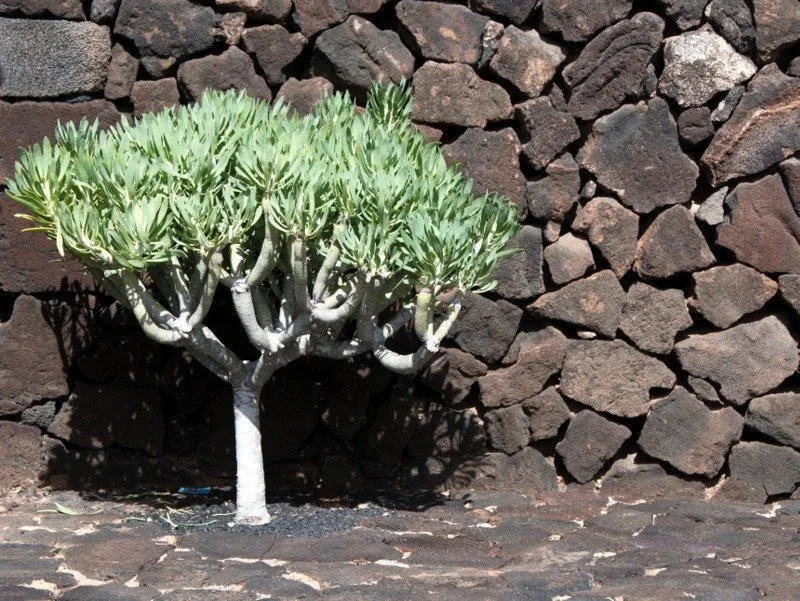

Opening hours at Jameos del Agua are every day from 10:00 to 18:00 (last entry 17:15) special opening from 19:00 – 01:00 Saturday and Tuesday. The restaurant is open from 11:30 to 16:30 and the cafeteria from 10:00 to 18:30. It costs €10.00 for Adults and €5,00 per child (7-12 years).
Mirador del Rio
El Mirador del Río is an observation point sitting high up on the Risco de Famara, in the north of the island. It’s barely visible from outside as it’s been integrated completely into the volcanic lava cliff face. Of course, it’s another César Manrique creation.
At an altitude of 474 metres, it’s the ideal spot for some spectacular views of the Archipiélago Chinijo Nature Reserve, Graciosa Island, Famara Cliff and down the island’s North West coast.

Inside the building are two white cavernous rooms with curved, smooth walls that contrast with the dark porous texture of the volcanic rocks outside. Two massive picture windows open onto the incredible view, but I preferred to enjoy it from the outdoor terrace.
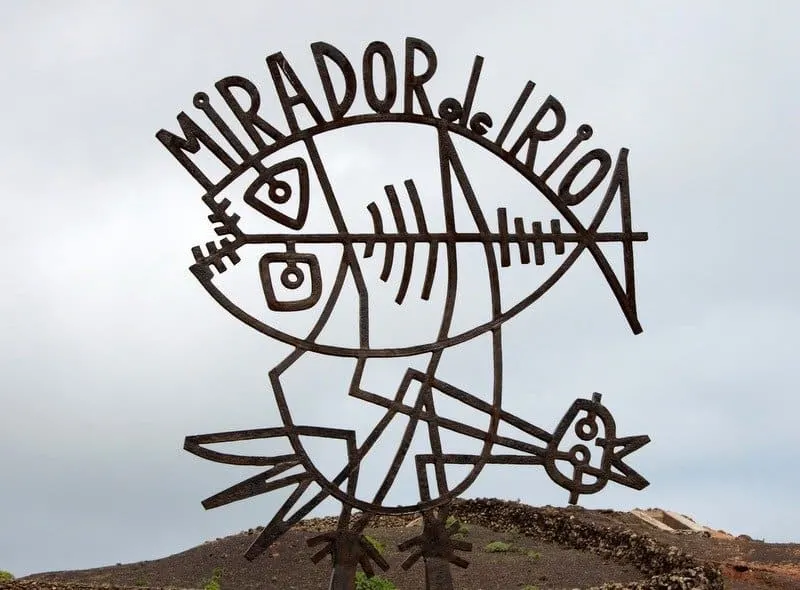
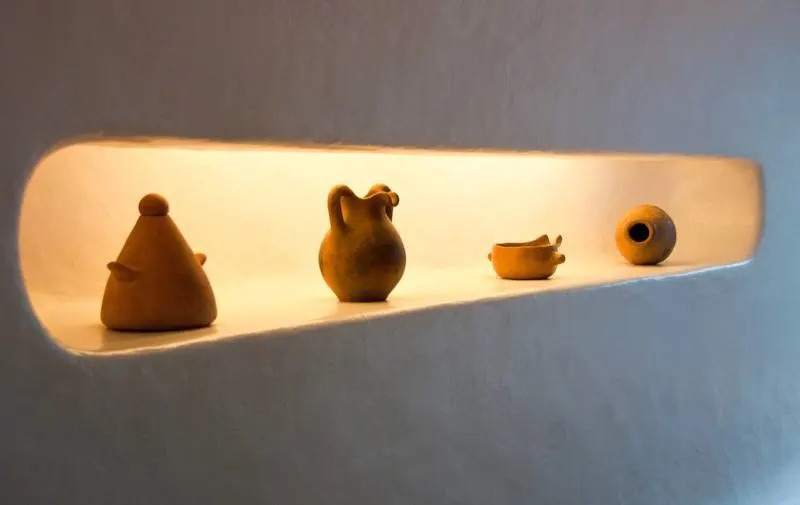
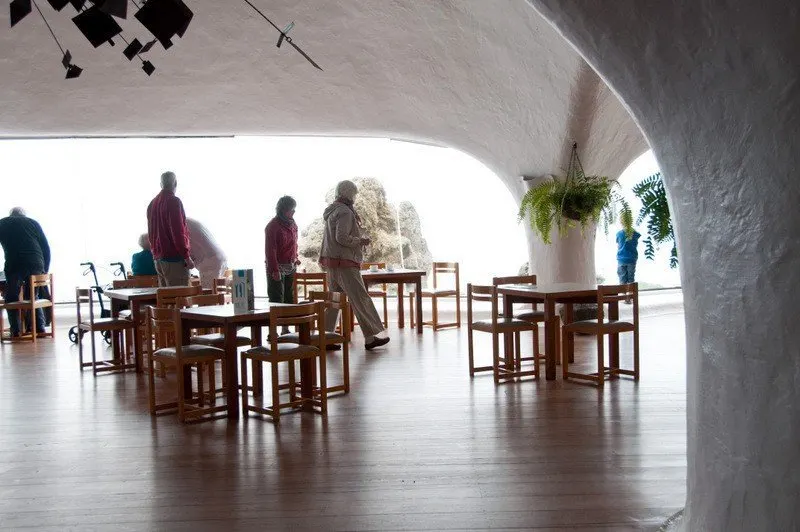
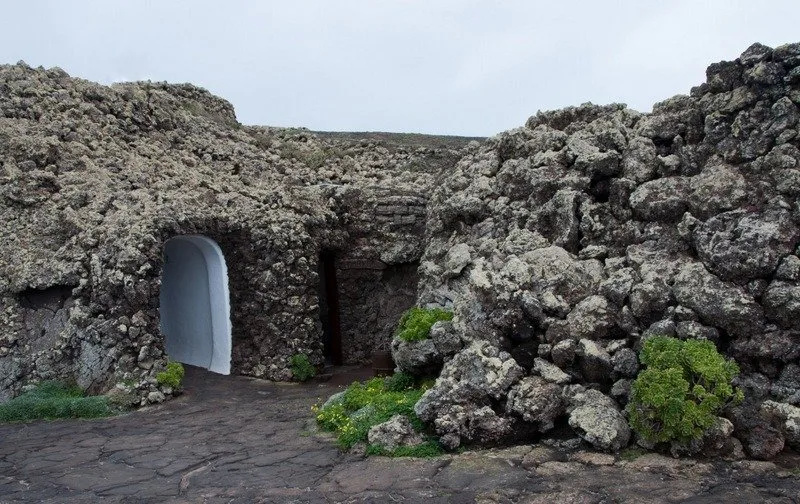
The island of La Graciosa is separated from Lanzarote by a narrow strip of sea called “El Río” (The River), which gives its name to the observation point. There are good views from the terrace of the Famara Cliff and the red-coloured “Salinas del Río” of “Guza”, the oldest salt pans in Lanzarote.
If you’re looking for spectacular views, this is one of the best things to do on Lanzarote.
Looking for somewhere to stay in Lanzarote? Check rates and availability
Mirador del Rio Opening Hours: 10:00 to 17:45 Summer opening hours (15 July to 15 September): 10:00 to 18:45 Closes at 16:45 on 24 and 31 December
Admission is €5.00 for adults and €2.70 for children – reductions apply for Canarian residents
Rent a car and explore Lanzarote
All three of the above attractions are near each other on the island’s north side, so it’s worth planning your Lanzarote itinerary to see all of them on the same day.
We hired a car and got around all the above sights plus the volcanoes in one day. It’s the way to go if you like to explore independently. Car rental was extremely affordable and as it’s a small island we didn’t spend a fortune on fuel. So, with four of us in the car it didn’t cost to much per person to get around.
The best part of renting a car is that when something catches your attention, you can pull over and check it out. And I can assure you we did precisely that!
Compare the best car hire rates for Lanzarote
Buy your map of Lanzarote to help with your journey.
Lanzarote Tours and Excursions
What to do in Lanzarote if you don’t want to drive? Well, that’s easy too because there’s a vast choice of excursions, day trips and tours. If you’re arriving by cruise ship, there’s a choice of day tours of the island too.
Looking for somewhere to stay in Lanzarote? Check rates and availability
Wine Tour of La Geria – Lanzarote’s Vineyards
Lanzarote has a wine-producing tradition that began as far back as the fifteenth century. Heading towards the centre of the island along the main road from San Bartolomé to Playa Blanca, you’ll find La Geria.
It’s an area of vineyards and wineries in the shadow of a brooding volcano range, which is one of the more unusual sights in the Canary Islands.
The vineyards in Lanzarote are unlike any you’ve ever seen before. In 1730, a massive eruption lasting six years covered this part of the island in thick, black volcanic ash, which put a stop to any cultivation except for the grapevine.
If you’re a wine lover, a wine tasting in La Geria is one Lanzarote attraction you won’t want to miss.
Zocos and Bodegas
Each vine is grown in a round hollow and surrounded by a small crescent-shaped wall called a Zoco. These protect the vines from the near-constant winds. There’s little rainfall in Lanzarote, and the volcanic ash preserves soil moisture around the plant, ensuring it has enough water to grow.
I went in February when the vines weren’t sprouting yet, but it was still worth visiting. The sight of row upon row of zocos sitting in seas of black sand was surreal.
There are plenty of bodegas to stop at for a tapas lunch, and of course, the wine is excellent…
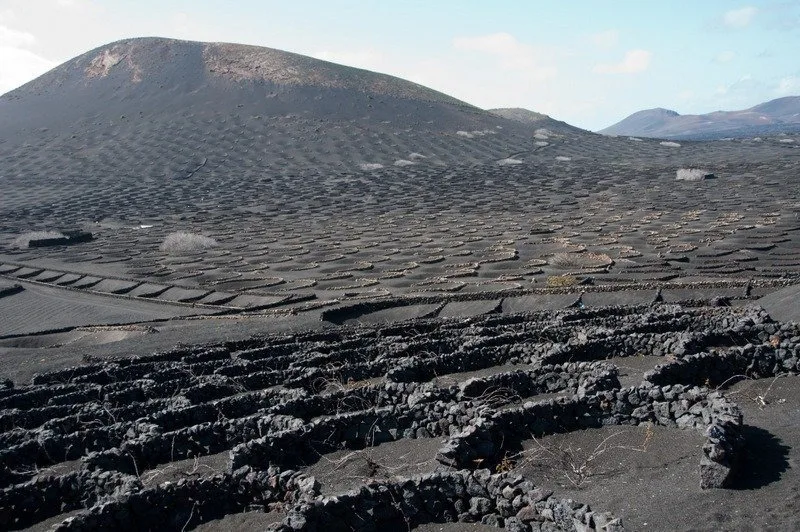
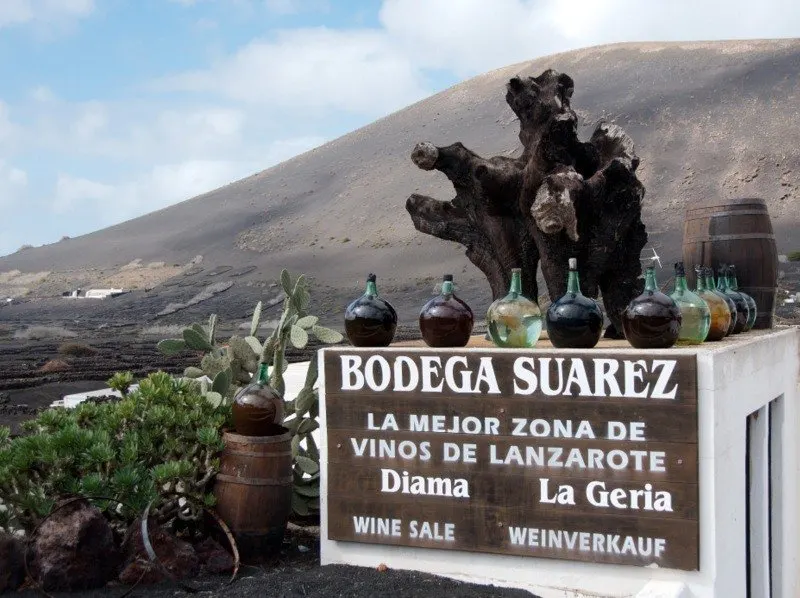
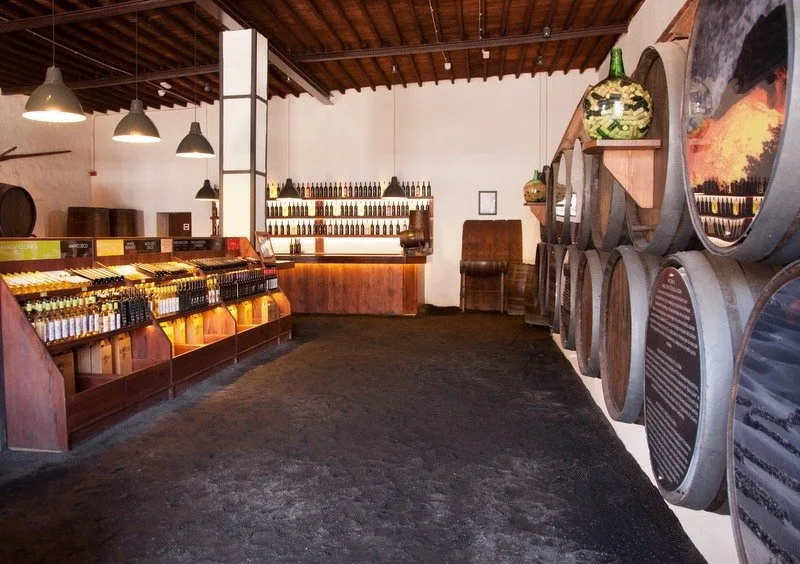
The César Manrique Foundation – Casa del Palmeral
The César Manrique Foundation is based in Taro de Tahiche,the former home of local artist César Manrique, and lies around a ten-minute drive from Arrecife.
Manrique took an organic approach and built his home into an old lava flow. The house comprises five underground cavern rooms set in natural volcanic bubbles, each connected to the next by underground tunnels.
The sunken garden and courtyard are calm spaces with traditional Canarian features, and the whole creation was completed in 1968.
The foundation also houses the best art gallery on Lanzarote, with a modern art collection including drawings by Picasso and Miro. There’s another gallery for smaller exhibitions, along with a shop and cafe.
Admission: €8 adults, children under 12 €1. Open: 10.00-18.00 Monday to Saturday, 10.00-15.00 Sunday
Looking for somewhere to stay in Lanzarote? Check rates and availability
Timanfaya National Park
Viewing the volcanic landscape and lava fields of Timanfaya National Park was the most breathtaking and my favourite of things to do on Lanzarote.
The Parque Nacional de Timanfaya covers an area of over 51 square km in the southwest of the island. These are the same volcanoes that blew their tops in 1730, covering the La Geria wine area in black ash and small pebbles of lapilli.
Lanzarote’s Volcanoes – Fire Mountains
A group of over 100 volcanoes, Montañas del Fuego (Fire Mountains) and their massive rippling lava fields make up Timanfaya National Park. It’s the main focus of Lanzarote’s UNESCO biosphere reserve.
If you’re wondering what to do in Lanzarote for outdoor enthusiasts, this is the one thing that’s not to be missed.
Intense heat rages under the earth here and you can witness the volcanic activity for yourself. We watched as a park ranger poured a bucket of water into a small hole in the lava. It burst back out seconds later in a plume of hot water and steam. You wouldn’t want to get too close! You can see this demonstration just by the el Diablo Restaurant which is a good stop for lunch or BBQ dinner.
Visitors aren’t permitted to walk unescorted. This is to protect the unique flora and fauna from trampling boots. If you’re really keen to explore, you can take the three-hour Ruta de Tremesana walk with a park ranger, but it’s advisable to book ahead as the walks get booked up quickly.
El Diablo Bus Tour
El Diablo buses leave from the nearby car park every 20 minutes to tour the volcano craters and lava fields, and the cost of the bus is included in your volcano tour entry fee. Pre-recorded Spanish, English and German commentaries share fascinating facts about the area as you pass by spectacular views of the craters and volcanic landscape.
Passengers are not allowed to disembark once the coach tour has started, so any photographs you want to take must be taken onboard. The ones below were all taken from the bus, so it is possible to get some good shots.
Top tip: Sit next to the window on the right-hand side of the bus for the best views.
Looking for somewhere to stay in Lanzarote? Check rates and availability
Lava Fields in Timanfaya National Park
The road ribbons through the lava field which, in places, looks as though it’s only just solidified from its cascading, bubbling path towards the coast. The scenery we passed was incredible, with steep slopes of grey and black around the gaping mouths of the cones.
Rust, orange and maroon peaks contrasted with ochre sands, while scrubby plants clung to the picon-covered slopes. The driver navigated some pretty tight bends to get the best views into the peaks.
Timanfaya National Park is located in the west of Lanzarote, off the LZ-67 between Yaiza and Tinajo. Enter at the gate and continue about 1 km up the road to the visitor centre, Islote de Hilario, to take in the fabulous views over the landscape.
If you don’t have a hire car you might want to consider a day tour of Timanfaya National Park.
Further along the LZ-67, there’s also an exhibition in Mancha Blanca which you could visit when you’ve finished exploring the park.
The park is open daily from 10.00 – 17.45. The El Diablo buses cost €10 adults and €4 for children. It’s one of the top things to do in Lanzarote and worth every last cent.
Top tip: If you plan to see more than two of these sights during your stay, you can buy a combi ticket for a group of attractions and save some euros. As you’ve seen, there’s quite a list of things to do on Lanzarote, so a combi ticket will help you budget.
We each bought a ticket for six attractions at €35 per adult which saved €12.50 per person. When you arrive at each attraction you have the option to buy a ticket for that venue alone or to purchase a bonus ticket. Read more her about the money-saving vouchers, costs and t&cs.
Papagayo Beach (Playa de Papagayo)
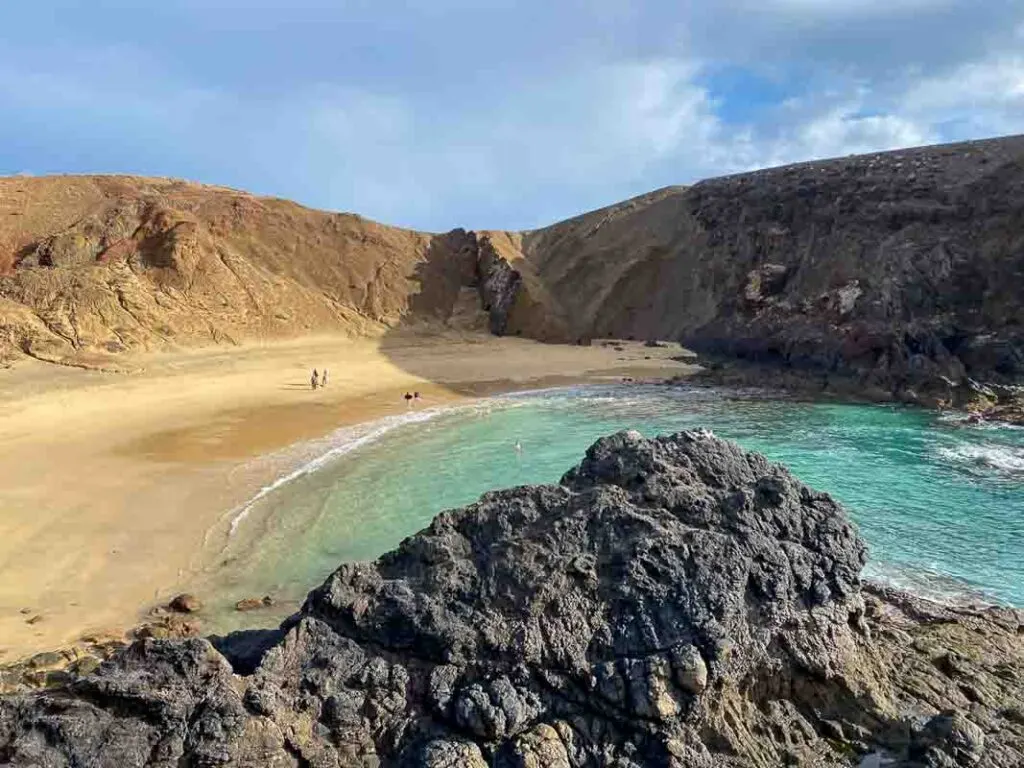
Papagayo Beach, Lanzarote, is believed by many to be one of the most beautiful beaches on the entire island, and I think I might agree with them. With long stretches of golden sand and turquoise waters, it’s one of the best places for swimming, snorkelling and other water sports. It’s also the perfect place to relax and enjoy the Lanzarote sun.
The area has four other beaches: Cera, Playa Mujeres, Caleta del Congrio and Muerto Muelas. Together, they’re known as Papagayo Beaches and are the best beaches on the island.
Papagayo Beach lies on Lanzarote’s southern coast, and you can reach it by boat or take a hire bike or car down the dirt track from Playa Blanca. If you go that way, you’ll need to take some euro coins to pay the toll on the dirt track.
But bear in mind that the car parks fill up quickly, and most car rentals don’t allow you to drive on unpaved roads. If your car runs into trouble on the dirt track, it could be expensive!
The easiest option might be to stay in the nearby town of Playa Blanca, where you can find a wide range of shops, restaurants and options for accommodation. Then you can simply walk down the steep steps to the golden sands of Playa del Papagayo, but don’t leave it too late in the day, or you might struggle to find a spot for your towel.
Papagayo Beach has few amenities, so remember to take beach chairs and sunshade along with your swimsuit, towel and sunscreen. Oh, and do bear in mind that the southern end of Papagayo Beaches tends to be popular with nudists!
Other nearby attractions in this area include the Aqualava Water Parks.
Salinas de Janubio (the salt flats)
Also on the west coast are the Janubio Salt Flats. You might want to swing by for a quick look en-route to the beach. It’s definitely worth pulling over for a quick look or stop at the visitor centre to find out more about Lanzarote’s salt industry on a guided tour and pick up a bag or two.
Looking for somewhere to stay in Lanzarote? Check rates and availability
Cueva de Los Verdes
Cueva de los Verdes is one of the places that you simply must visit in Lanzarote. It’s one of the lava tubes found in a protected area of Northern Lanzarote called the Monumento Natural del Malpaís de La Corona. You can explore the cave on an hour-long guided tour, and it’s quite unlike any other cave you might have visited.
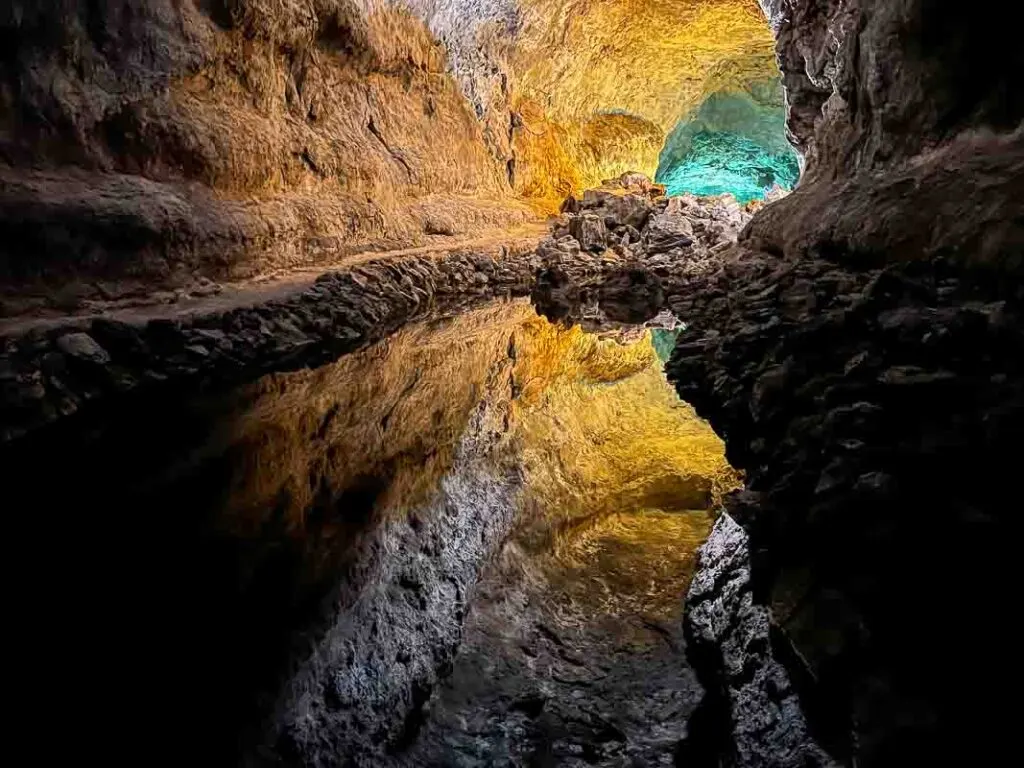
The lava tubes formed around four thousand years ago when molten lava cascaded down from the Monte Corona volcano into the Atlantic Ocean. As the lava cooled, it formed a crust which emptied to create a volcanic tunnel. This tunnel stretches above sea level for 6km and then dips below the sea for a further 1.5km.
The caves were used as a hiding spot from pirate attacks in the 16th and 17th centuries. Cueva de Los Verdes translates in English as the Green Caves, but the name comes from a local family of goat herders rather than the colour.
There’s plenty of free parking at Cueva de Los Verdes. However, the best time to visit is early morning as this is a popular tourist attraction in Lanzarote, and tours are limited to 50 people. If you can get there before opening time, you should be able to go into the tunnel on one of the day’s first tours. The guided tours are in Spanish and English, with the guide narrating in each language in turn before moving on.
This is a fascinating tour, but be sure to wear comfy trainers as the tunnels can be steep, and there are quite a few steps as well.
Top tip: If you’re also planning to visit the Jameos del Agua caves and the nearby Jardín de Cactus, you could buy a combination ticket for all three attractions, which can save you a few euros.
Admission: €9 adults, children 7-12 €4.50, concessions available for Canary Island residents. Open: 10.00-18.00 daily in summer.
Looking for somewhere to stay in Lanzarote? Check rates and availability
Costa Teguise
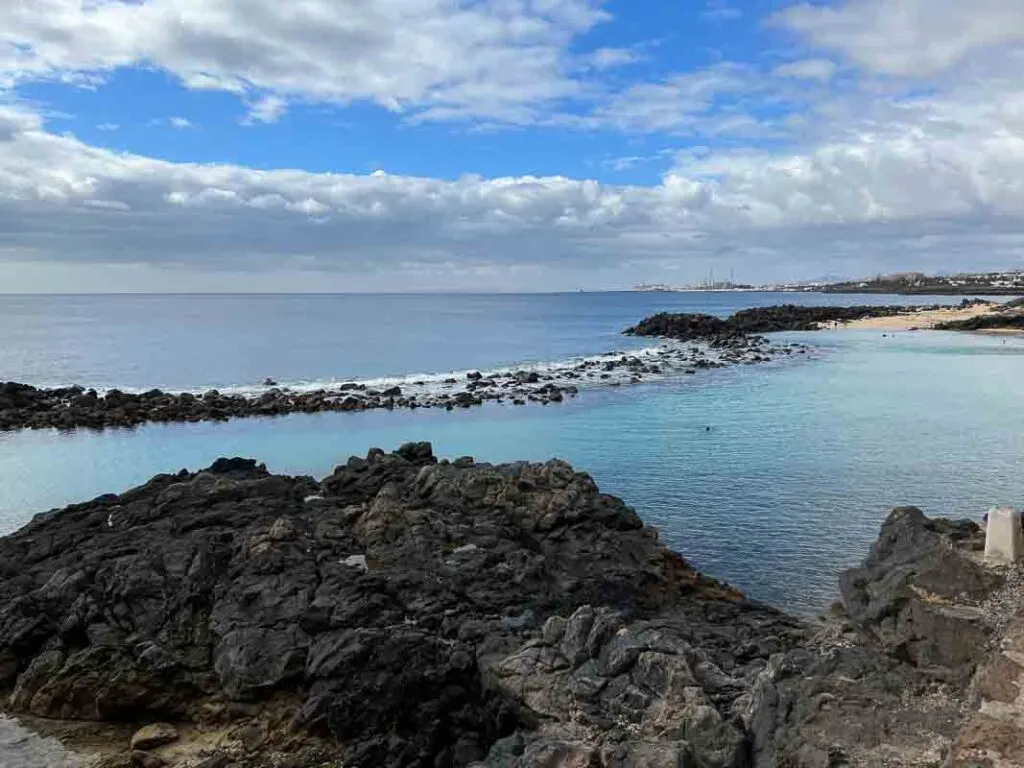
Our base for our recent visit to Lanzarote was the small town of Costa Teguise. This is the island’s third largest tourist resort and can be found on the island’s southeast coast. Work on the town started in the 1970s under the guidance of César Manrique, and it was initially intended to be an upscale alternative to Puerto del Carmen.
Like most purpose-built tourist towns, Costa Teguise has plenty of tourist shops, a wide array of places to eat, and bars playing live music. It’s not as lively as Puerto del Carmen, but there’s still a thriving nightlife. If you’re on a self-catering holiday, you’ll find a few small supermarkets in town and a larger store on the outskirts of Costa Teguise, which is good for fresh fish and meat.
Looking for somewhere to stay in Lanzarote? Check rates and availability
Costa Teguise is just a 15-minute drive from Arrecife Airport, making it convenient for arrival and departure days, and it’s close to plenty of the best things to do in Lanzarote. You can head to the island’s former capital of Teguise and explore the quaint cobbled streets or the bustling local markets. Or go a little further afield and visit the modern-day capital of Arrecife, with its two castles and busy shopping street.
You have the choice of several beaches, from the small beach at Playa El Ancla to the white sands of Las Cucharas Beach. The town is also close to some of the most popular things to do in Lanzarote, like the César Manrique Foundation, Aqualava Waterpark, Jameos del Agua and the Jardin de Cactus.
Looking for somewhere to stay in Lanzarote? Check rates and availability
Teguise Old Town
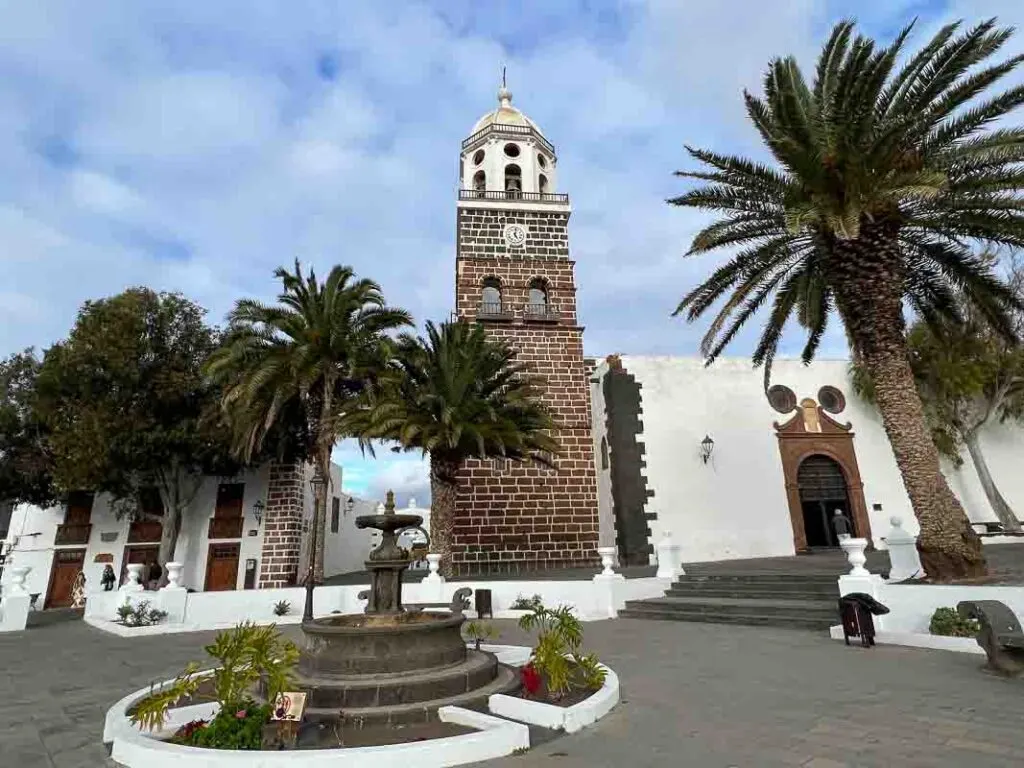
Teguise old town, known to locals as La Villa de Teguise, is considered to be the oldest town in the whole of the Canary Islands. This tiny whitewashed town, lined with palm trees, was the capital of Lanzarote for over 450 years until 1852 when Arrecife took over the role.
This charming town is a great place to visit for its 15th century castle, music museum, and handicraft market. There are cafes and bars and on Sunday the town comes alive with the weekly market which sells local hand-crafted goods, produce souvenirs which’ll look entirely out of place once you get them home.
Read more in this Costa Teguise review.
Museo Internacional de Art
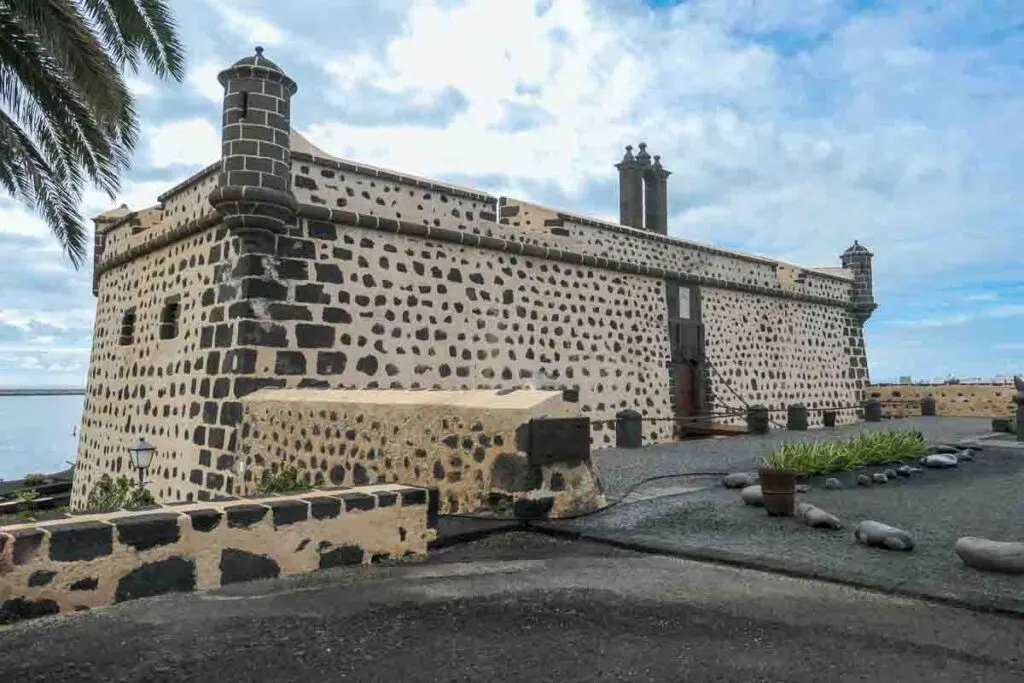
The Museo Internacional de Arte Contemporáneo (MIAC) is located in the historic fortress of Castillo de San José in Arrecife. This was built by King Charles III of Spain in the 1700s to protect the local population from starvation during times of famine, which is why it was known as the “Fortress of Hunger”.
In the 1970s, it was refurbished under the direction of César Manrique, and it became the home of the International Museum of Contemporary Art in 1976. MIAC was the first contemporary art museum in the Canary Islands and houses a stunning collection of works by Canarian, Spanish and international artists, including local artist Pancho Lasso.
Most of the museum’s exhibits date from between 1950 and 1980, and there’s a range of abstract art forms, including kinetic art and modern sculpture. It will take you around an hour to look around the museum.
There’s also a spectacular restaurant with curved floor-to-ceiling windows that look out over the docks and harbour below.
Admission: €4 adults, children 7-12 €2, various concessions available. Open: 11.00-18.00 365 days a year.
There are plenty of buses and taxis available, but if you’re planning to explore more of the island, it’s easier to hire a car.
Looking for somewhere to stay in Lanzarote? Check rates and availability
Ready to plan your holiday to Lanzarote?
- To get the best deals on flights, compare cheap prices with Skyscanner flight comparison site
- Book your airport transfers with Welcome Transfers
- Find the perfect place to stay on Booking.com
- Compare prices for your car hire
- Explore your destination through local experiences
- If you think you need a visa check with iVisa
- Plan your trip with maps and guide books
- I use a Wise account multi-currency debit card. Easy to top up, low fees and better exchange rates.
- And, finally, please don’t forget to protect you and your trip with travel insurance. I’m very happy with my Heymondo travel insurance.
So, now you know the best things to do in Lanzarote. If you have any questions drop me a dm on Instagram. I’d love to hear from you. If there are any other things to do on Lanzarote let us know in the comments below so we can add to our list.
Read about more Spanish islands…
Menorca – 25 reasons to visit Menorca – Majorca – A world of Wander at Iberostar Grand Portals Nous and Gourmet Dining at Iberostar Grand Portals Nous. Why Tenerife is a great island to visit in January and why you should visit North Tenerife.
Planning a Lanzarote trip? Pin it for later…
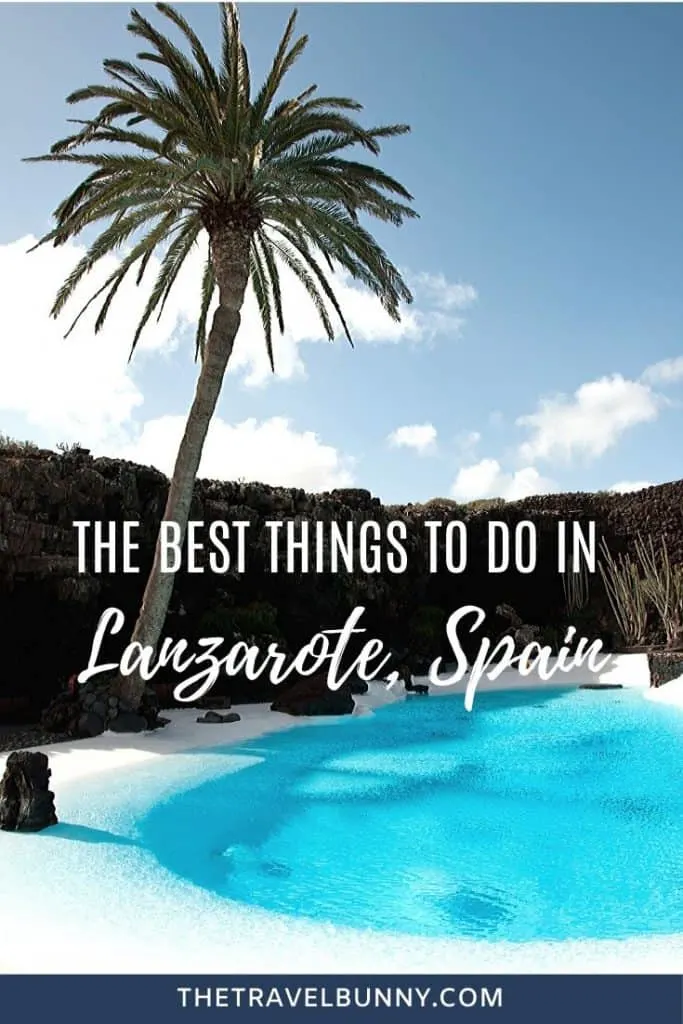
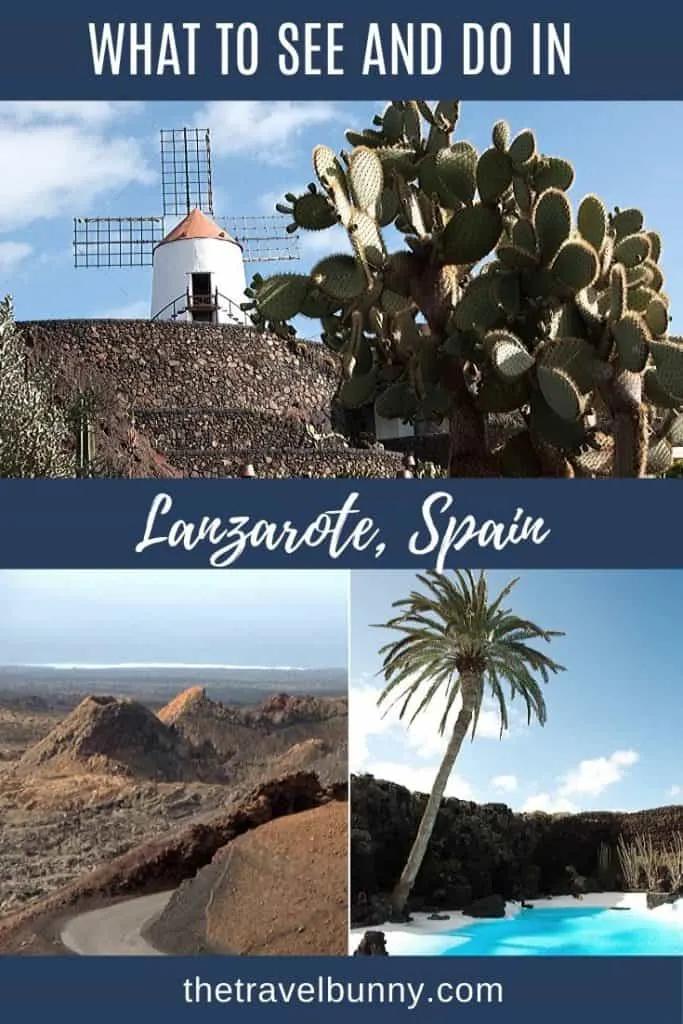

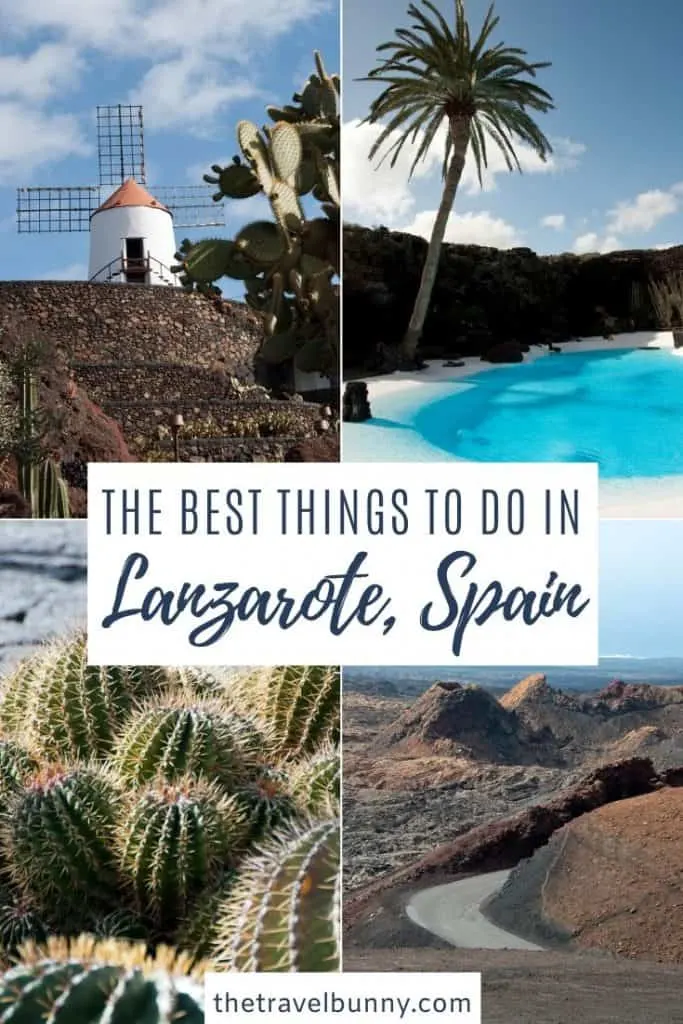
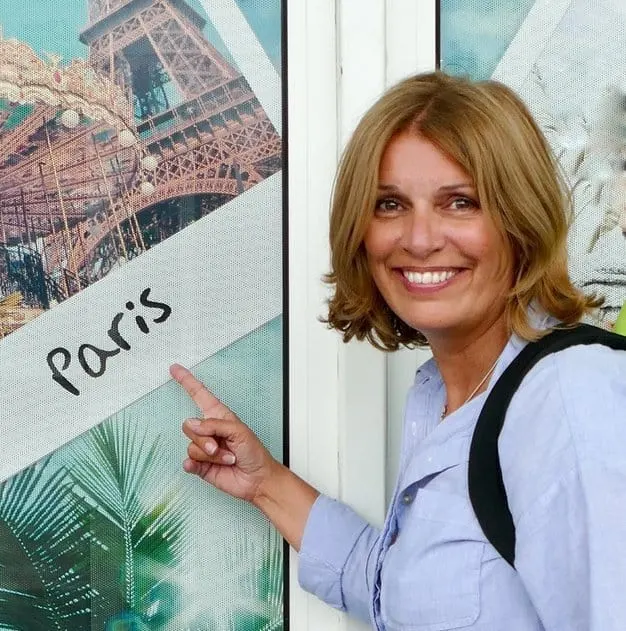
Suzanne Jones is a full-time travel blogger and writer at The Travelbunny website which she started in 2011 during her time as a professional travel planner. This serial traveller enjoys exploring new destinations, culinary encounters and the outdoors. When she’s not indulging her wanderlust or writing about her adventures you’ll most likely find Suzanne, camera in hand, enjoying coastal walks on England’s South Coast.
Suzanne also runs Hello Sussex a website which showcases the best of East & West Sussex. Read more about Suzanne here…

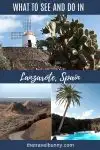
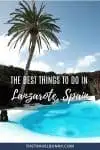

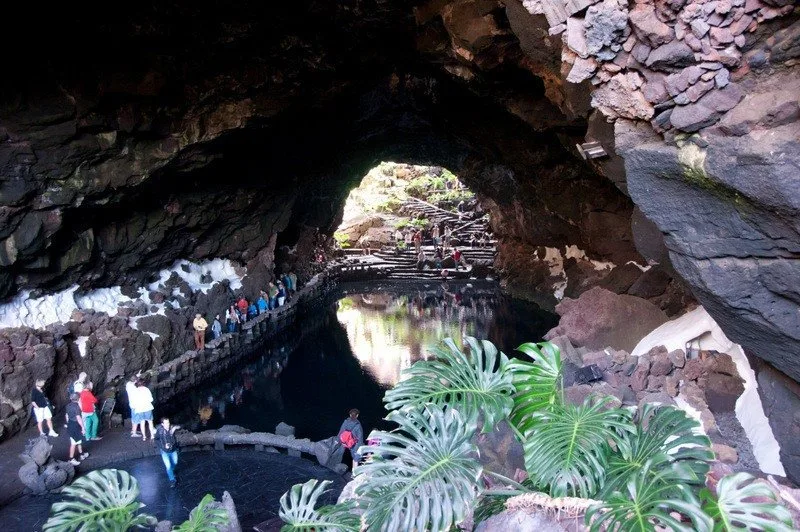
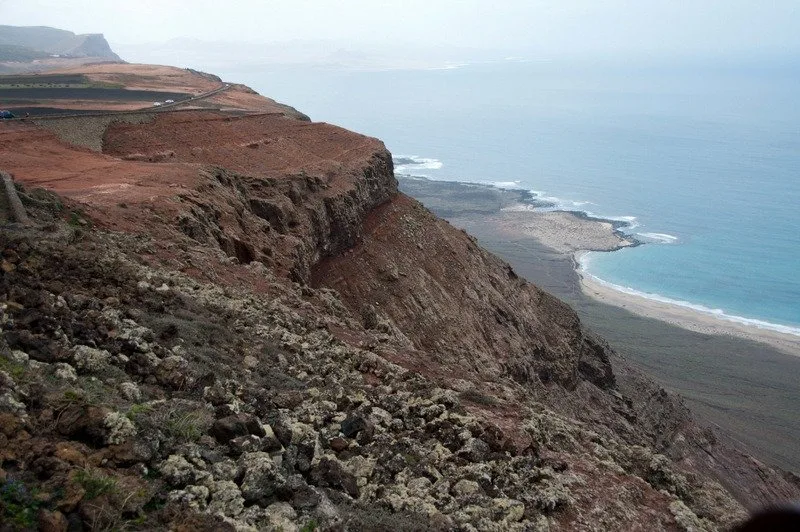
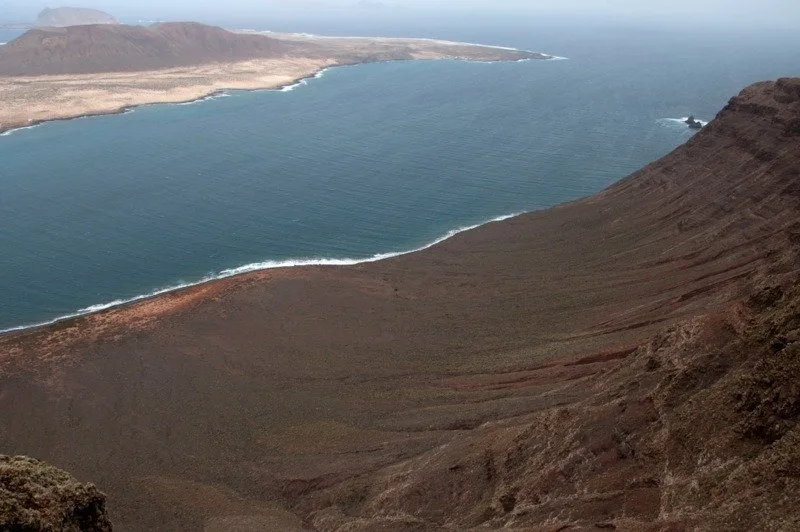
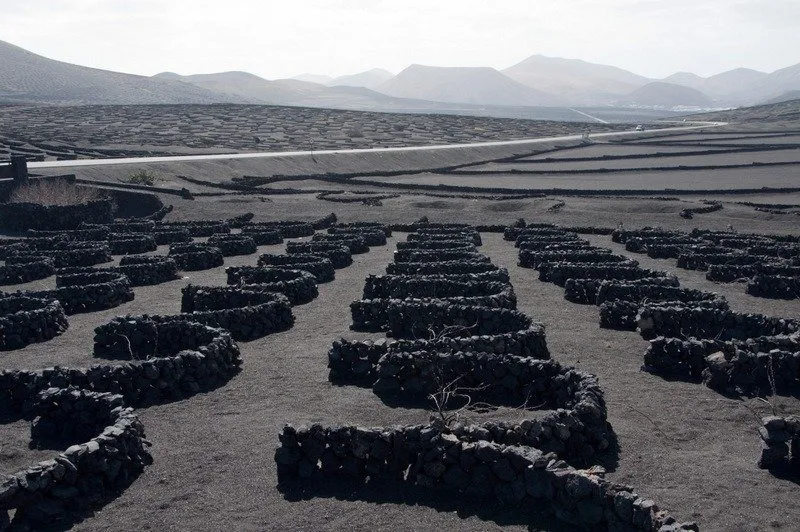
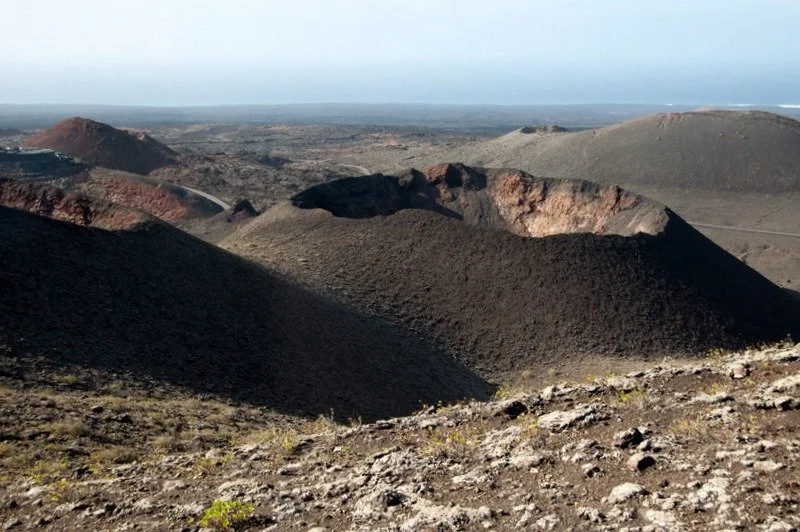
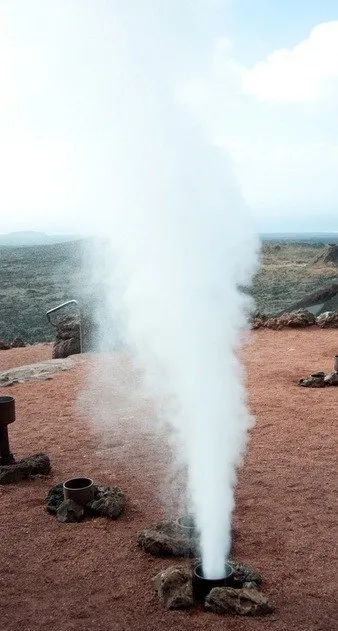
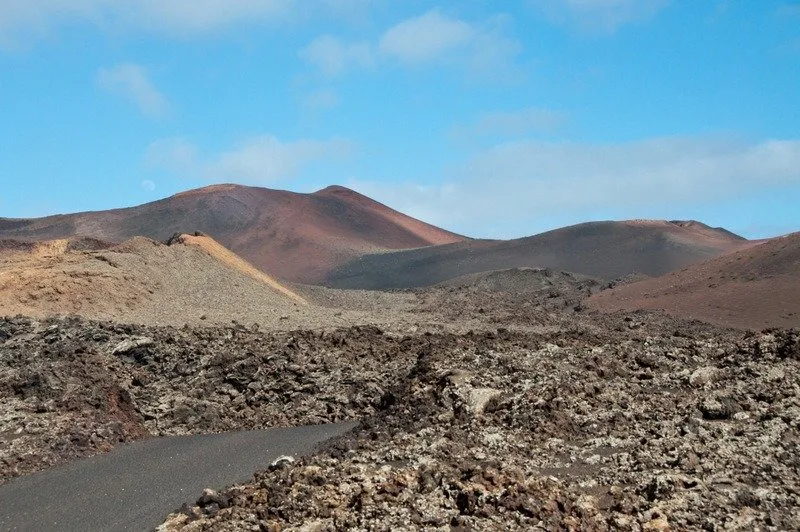
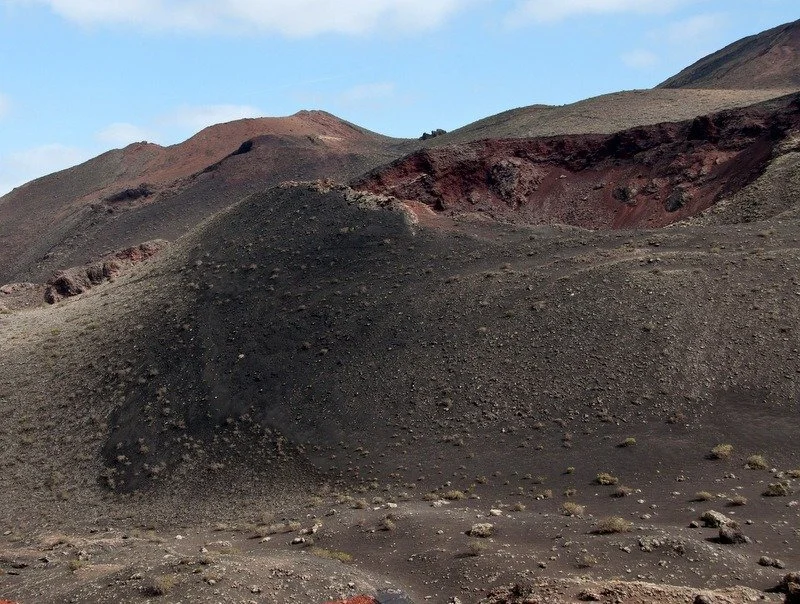
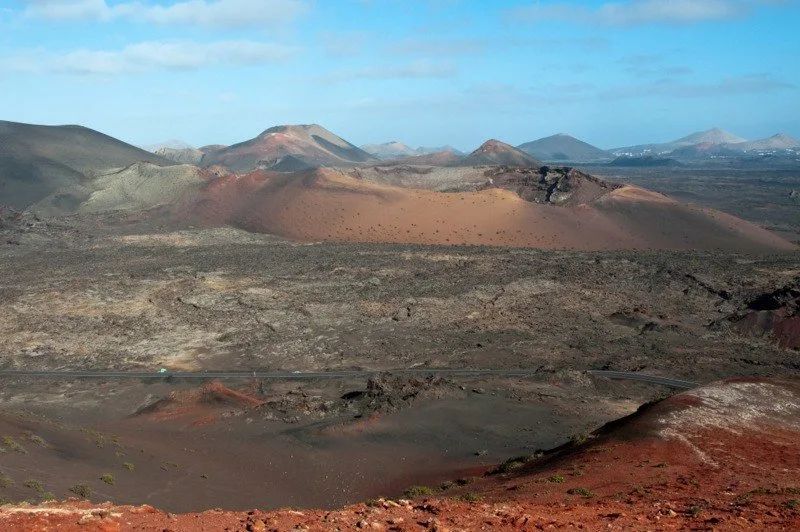
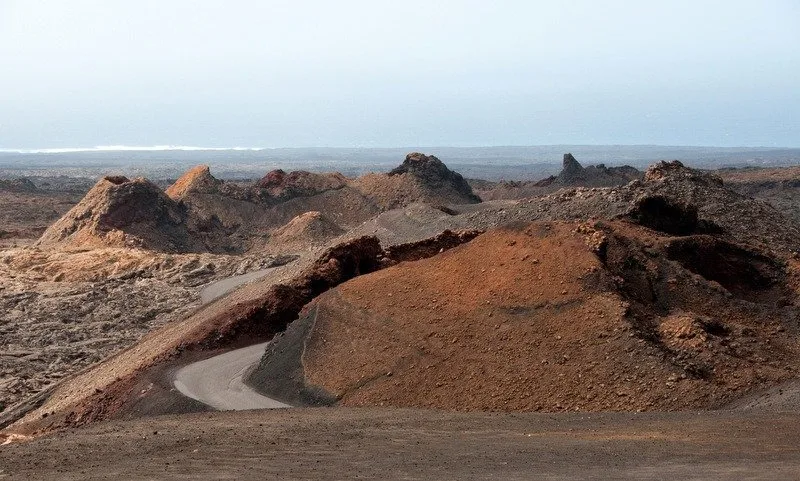
sheri
Thursday 27th of August 2015
What a great post. I'm planning a trip to Lanzarote next month and really couldn't find the best information on it. Love the post and the photos. Thanks for sharing. Did you happen to do the 3 hour hike? What was it like? I would love to photograph some sights from the park, but being on a bus wouldn't allow that. Thanks!
Suzanne Jones
Thursday 27th of August 2015
Hi Sheri, we didn't do the hike as we didn't have time - I'd have loved to though. Some of the photos in the post were taken from the bus. I had to watch for reflections but they didn't come out too badly. Thanks for stopping by and glad the post was useful :)
Travelbunny Highlights 2014 | The Travelbunny
Thursday 13th of August 2015
[…] from ice to fire and some winter sunshine on a work trip as I took a group of incentive winners to Lanzarote in The Canary Islands. I’ve visited Tenerife and La Gomera but this was my first trip to the […]
mae
Thursday 26th of February 2015
Indeed, this beautiful place is under-rated. Thanks for sharing! :)
Suzanne Jones
Thursday 26th of February 2015
Isn't it just! Thanks for reading :)
Shikha (whywasteannualleave)
Tuesday 26th of August 2014
Never been to Lanzarote - love how incredible the volcanic scenery looks - I never realised it had landscape like this!
Suzanne Jones
Tuesday 26th of August 2014
The landscape was amazing - there are a couple of other sights I'd liked to have seen but was working so didn't have time.
Lucy
Tuesday 26th of August 2014
The volcanic landscape looks really dramatic - a bit like you'd imagine being on another planet! I don't know a great deal about the Canary Islands but looks like there's a lot to see beyond the obvious beachy/package holiday side you might normally think of.
Suzanne Jones
Tuesday 26th of August 2014
There were other sights I'd liked to have seen - a luminous green lake, other lava tubes and some of the old villages. Sadly I only had one day to check out the island.